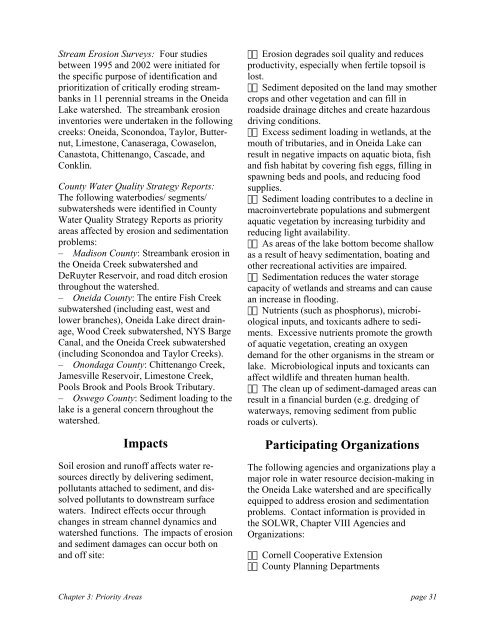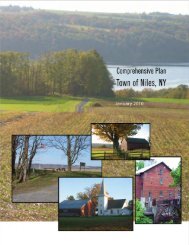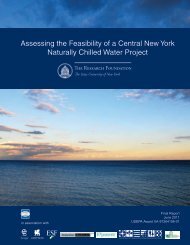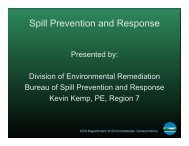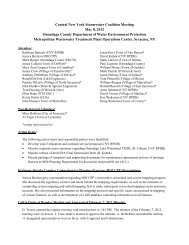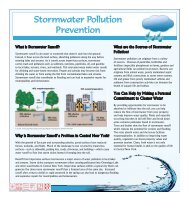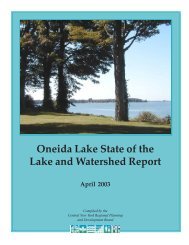A Management Strategy for Oneida Lake and its ... - CNY RPDB Home
A Management Strategy for Oneida Lake and its ... - CNY RPDB Home
A Management Strategy for Oneida Lake and its ... - CNY RPDB Home
Create successful ePaper yourself
Turn your PDF publications into a flip-book with our unique Google optimized e-Paper software.
Stream Erosion Surveys: Four studies<br />
between 1995 <strong>and</strong> 2002 were initiated <strong>for</strong><br />
the specific purpose of identification <strong>and</strong><br />
prioritization of critically eroding streambanks<br />
in 11 perennial streams in the <strong>Oneida</strong><br />
<strong>Lake</strong> watershed. The streambank erosion<br />
inventories were undertaken in the following<br />
creeks: <strong>Oneida</strong>, Sconondoa, Taylor, Butternut,<br />
Limestone, Canaseraga, Cowaselon,<br />
Canastota, Chittenango, Cascade, <strong>and</strong><br />
Conklin.<br />
County Water Quality <strong>Strategy</strong> Reports:<br />
The following waterbodies/ segments/<br />
subwatersheds were identified in County<br />
Water Quality <strong>Strategy</strong> Reports as priority<br />
areas affected by erosion <strong>and</strong> sedimentation<br />
problems:<br />
– Madison County: Streambank erosion in<br />
the <strong>Oneida</strong> Creek subwatershed <strong>and</strong><br />
DeRuyter Reservoir, <strong>and</strong> road ditch erosion<br />
throughout the watershed.<br />
– <strong>Oneida</strong> County: The entire Fish Creek<br />
subwatershed (including east, west <strong>and</strong><br />
lower branches), <strong>Oneida</strong> <strong>Lake</strong> direct drainage,<br />
Wood Creek subwatershed, NYS Barge<br />
Canal, <strong>and</strong> the <strong>Oneida</strong> Creek subwatershed<br />
(including Sconondoa <strong>and</strong> Taylor Creeks).<br />
– Onondaga County: Chittenango Creek,<br />
Jamesville Reservoir, Limestone Creek,<br />
Pools Brook <strong>and</strong> Pools Brook Tributary.<br />
– Oswego County: Sediment loading to the<br />
lake is a general concern throughout the<br />
watershed.<br />
Impacts<br />
Soil erosion <strong>and</strong> runoff affects water resources<br />
directly by delivering sediment,<br />
pollutants attached to sediment, <strong>and</strong> dissolved<br />
pollutants to downstream surface<br />
waters. Indirect effects occur through<br />
changes in stream channel dynamics <strong>and</strong><br />
watershed functions. The impacts of erosion<br />
<strong>and</strong> sediment damages can occur both on<br />
<strong>and</strong> off site:<br />
•Erosion degrades soil quality <strong>and</strong> reduces<br />
productivity, especially when fertile topsoil is<br />
lost.<br />
•Sediment deposited on the l<strong>and</strong> may smother<br />
crops <strong>and</strong> other vegetation <strong>and</strong> can fill in<br />
roadside drainage ditches <strong>and</strong> create hazardous<br />
driving conditions.<br />
•Excess sediment loading in wetl<strong>and</strong>s, at the<br />
mouth of tributaries, <strong>and</strong> in <strong>Oneida</strong> <strong>Lake</strong> can<br />
result in negative impacts on aquatic biota, fish<br />
<strong>and</strong> fish habitat by covering fish eggs, filling in<br />
spawning beds <strong>and</strong> pools, <strong>and</strong> reducing food<br />
supplies.<br />
•Sediment loading contributes to a decline in<br />
macroinvertebrate populations <strong>and</strong> submergent<br />
aquatic vegetation by increasing turbidity <strong>and</strong><br />
reducing light availability.<br />
•As areas of the lake bottom become shallow<br />
as a result of heavy sedimentation, boating <strong>and</strong><br />
other recreational activities are impaired.<br />
•Sedimentation reduces the water storage<br />
capacity of wetl<strong>and</strong>s <strong>and</strong> streams <strong>and</strong> can cause<br />
an increase in flooding.<br />
•Nutrients (such as phosphorus), microbiological<br />
inputs, <strong>and</strong> toxicants adhere to sediments.<br />
Excessive nutrients promote the growth<br />
of aquatic vegetation, creating an oxygen<br />
dem<strong>and</strong> <strong>for</strong> the other organisms in the stream or<br />
lake. Microbiological inputs <strong>and</strong> toxicants can<br />
affect wildlife <strong>and</strong> threaten human health.<br />
•The clean up of sediment-damaged areas can<br />
result in a financial burden (e.g. dredging of<br />
waterways, removing sediment from public<br />
roads or culverts).<br />
Participating Organizations<br />
The following agencies <strong>and</strong> organizations play a<br />
major role in water resource decision-making in<br />
the <strong>Oneida</strong> <strong>Lake</strong> watershed <strong>and</strong> are specifically<br />
equipped to address erosion <strong>and</strong> sedimentation<br />
problems. Contact in<strong>for</strong>mation is provided in<br />
the SOLWR, Chapter VIII Agencies <strong>and</strong><br />
Organizations:<br />
•Cornell Cooperative Extension<br />
•County Planning Departments<br />
Chapter 3: Priority Areas page 31


